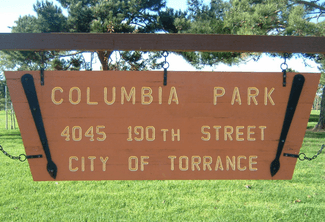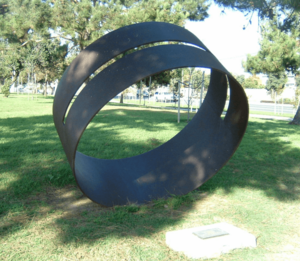Columbia Park, Torrance, California facts for kids
Quick facts for kids Columbia Park |
|
|---|---|

The entrance sign for Columbia Park,
in Torrance, California |
|
| Type | Public recreational urban regional park |
| Location | Torrance, California, United States |
| Area | 52 acres (21 ha) |
| Created | 1983 |
| Operated by | Torrance City Council |
| Open | All year |
Columbia Park is a large, fun park in Torrance, California. It covers about 52 acres, which is like 52 football fields! This park is a great place for sports, relaxing, and enjoying nature. It has soccer fields, baseball diamonds, and even special gardens where people can grow plants. Columbia Park is one of many parks in Torrance that help people stay active and connected to their community.
Contents
What Can You Do at Columbia Park?
Sports and Fun Activities
Columbia Park is a hub for sports! You'll find six soccer fields and two baseball diamonds, perfect for games and practice. There's also a roller hockey rink for those who love to skate and play.
If you enjoy walking or jogging, the park has a long path that's about 1.32 miles (2.12 km) long. It's split into two sections, making it easy to choose a shorter or longer route. This path is also used for competitive cross country running races. The soccer fields even have lights, so you can play even after the sun goes down!
Community Gardens
Columbia Park has a special area called the Community Garden. Here, local residents can rent small plots of land to grow their own fruits, vegetables, and flowers. It's a wonderful way to learn about gardening and meet other people who love to grow things. The park also hosts a Home Garden Learning Center, where you can learn about composting and other gardening tips.
History of Columbia Park
How the Park Started
The idea for Columbia Park began in 1970, and the park officially opened in 1983. A man named Edward J. Ferraro, who was the Torrance City Manager, helped get the land for the park. He worked to get about 50 acres of land to create this amazing green space for everyone to enjoy.
The park is located next to an oil refinery and has a tall radio antenna that helps broadcast news for a Los Angeles radio station. There are also large electrical towers that carry power to homes and businesses.
Art in the Park
In 1983, a cool sculpture called "Fujimihara" was added to the park. It was created by an artist named Roger Berry and is located in the southwest part of Columbia Park. It's a great example of public art that adds beauty to the park.
Women's Soccer Stars
In the late 1980s, Columbia Park became a very important place for women's soccer. A famous club team called 'Ajax America Women' used the park as their home field. Two amazing players, Joy Biefeld-Fawcett and Carin Jennings, regularly practiced and played here. These two players went on to achieve incredible success:
- They helped 'Ajax' win the U.S. women's amateur championship.
- They were part of the U.S. national team that won the very first FIFA Women's World Cup in China in 1991! It's pretty cool that they trained right here at Columbia Park.
Park Improvements
When Columbia Park first opened, it was mostly for field sports. But people also wanted places to walk and jog. So, in 1984, a landscape designer named Paul Saito came back to redesign the park. He added winding concrete pathways and running trails, making it even better for exercise and enjoying the scenery. He even won an award for his creative design!
Over the years, the park has continued to grow and improve. In 1985, more land was added to the southwest part of the park. Later, around 2000, plans were made to add more parking spaces and nice gazebos for people to relax under.
Trees and Nature
Earth Day Tree Planting
On Earth Day in 1995, a tree was planted in Columbia Park by a group called "The Friends of Madrona Marsh." This was to celebrate the 25th anniversary of Earth Day, showing how important it is to care for our planet.
Cherry Blossom Trees
In 2001, a Buddhist group called Soka Gakkai International USA made a wonderful donation to Torrance. They paid for 100 cherry blossom trees! The plan was to plant 10 cherry trees in Columbia Park each year for ten years. These beautiful trees add a lot of color and peace to the park, and they were planted to help create a more peaceful environment in the community. By 2007, 70 cherry trees had been planted, and the group even increased their donation to 30 trees per year!
Living Tribute Trees
Torrance has a "Living Dedication Tree Program" at Columbia Park. This program allows families, individuals, or groups to sponsor the planting of a new tree in the park. It's a special way to honor someone or remember an important event with a living tribute.
Park Challenges and Solutions
Skate Sailing Rules
In the mid-1980s, the long, smooth paths and empty parking lots at Columbia Park became popular for "sail-skating." This is where people use skateboards or roller skates with a sail to go really fast! One person was even clocked by police radar going 40 miles per hour (64 km/h) inside the park! Because it could be dangerous, the Torrance City Council made a rule in 1985 that made it illegal to use wheeled vehicles with sails in city parks or on public streets.
The Gopher Problem
When Columbia Park was new, its big grassy areas became a perfect home for gophers. There were more than 600 gophers, and their holes made it hard to use the fields for sports. Even hawks would come to the park to hunt the gophers!
In 1987, the city brought in Hank "G-Man" Baranowski, who was known for being great at getting rid of gophers. Within a few months, he solved the gopher problem at Columbia Park. After that, the sports fields could be used regularly again.
Making Paths Safer
In 2001, parts of the jogging path in Columbia Park would sometimes flood or get slippery because of sprinklers. To fix this, the city raised those sections of the path and added a special material called decomposed granite to help drain the water. This made the paths much safer for everyone.
Play Equipment Updates
For a while, Columbia Park had an old firetruck that kids could play on. But in 2003, it was found that the firetruck didn't meet modern safety rules for playgrounds. To keep kids safe, it was fenced off. Then, in 2006, the firetruck was removed completely. The city planned to replace it with new, fun, and safe play equipment with soft rubber matting underneath.
Dog Parks Discussion
In 2006, Torrance considered adding fenced-in dog parks to Columbia Park (and Wilson Park). These would have separate areas for large and small dogs to run around off-leash. However, after looking into it, the city council decided that a dog park wasn't essential for Torrance at that time. They felt there wasn't enough unused space and that it could lead to problems like dog fights or the spread of diseases.


